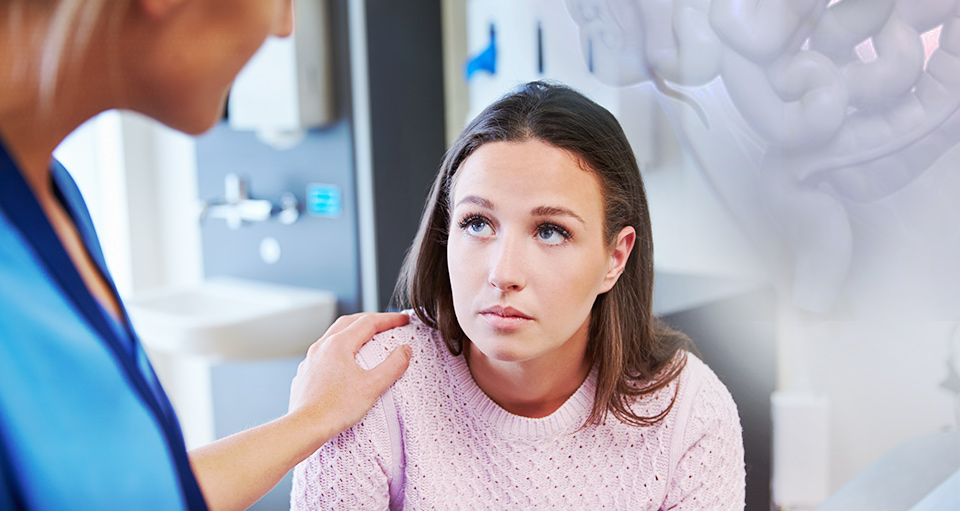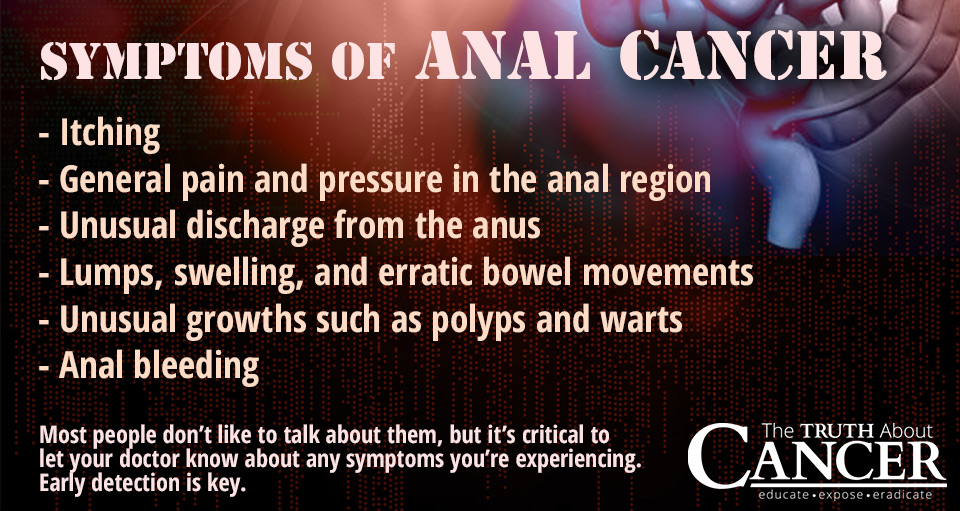Anal cancer is not exactly the easiest subject matter to discuss, which is probably why we rarely hear anything about it in the media. (One exception being in 2009, when actress Farrah Fawcett’s death from anal cancer briefly made headlines.)
Both its taboo location and being considerably less common than its more well-known counterparts of colon cancer and cancer of the rectum has kept anal cancer on the fringes of the national conversation about cancer.
Anal cancer, also known as cancer of the anus, is a somewhat rare condition that afflicts roughly 8,000 new people in the United States every year. Though not nearly as prevalent as cancers of the colon and rectum, anal cancer is on the rise. The American Cancer Society now warns that 1 in 500 people will be diagnosed with it at some point throughout their lives.
This translates to more than half a million Americans who at some point will face this serious disease. Though highly treatable, what makes anal cancer a tougher nut to crack than other forms of cancer seems to be its anatomical locale. Adding to the problem is the tendency of potential sufferers to avoid talking about it with their healthcare practitioners out of embarrassment.
Talking about anal cancer might make some people blush, but failure to address it early on can mean a death sentence, which is no laughing matter. This is why advocacy groups have designated March 22 as Anal Cancer Awareness Day. This day is specially set aside to spread the word about anal cancer symptoms, as well as available treatment options and prevention tips.
Anal Cancer Symptoms: Early Detection is Key
Since the anus is technically part of the intestines, cancers that form there are complex and come in many varieties. The most common type of anal cancer is squamous cell carcinoma, which typically forms in the outer lining of the anal canal. But there’s also cloacogenic carcinoma and adenocarcinoma, as well as basal cell carcinoma and melanoma, both of which are cancers of the skin.
Anal cancer symptoms range from general pain and pressure in the anal region during the earlier stages of the disease, as well as itching, unusual discharge from the anus, lumps, swelling, and erratic bowel movements. In more severe cases, anal bleeding is common. Unusual growths such as polyps and warts may also be an indication of anal cancer, though this is not always the case.
Risk factors for anal cancer include frequent anal irritation, cigarette smoking, and compromised immunity. Concerning the latter two, this is one of the many reasons why I’m constantly urging people to quit the tobacco habit and boost their immune systems through healthy diet and appropriate exercise. Doing so could, quite literally, save your life!
Obviously the goal is to lower the risk factors to avoid ever developing these anal cancer symptoms in the first place. But if you do happen to see worrying signs that could indicate the presence of anal cancer, it’s important to get checked out. This will either rule out a diagnosis or get you on track to eradicating the cancer as quickly as possible.
Don’t Be Afraid of Getting Tested for Anal Cancer
If you’re worried that you might have cancer of the anus, there are several cancer diagnostic approaches you can take. One is to opt for a digital rectal exam, or DRE, which involves a doctor carefully scoping out the anal cavity for lumps or other abnormalities. If any suspicious finds occur during this DRE, the doctor may decide to perform an anoscopy, which involves inserting a small anoscope into the anus to gain clearer visuals of what might be lurking.
Biopsies, ultrasounds, x-rays, CT scans, MRIs, and PET scans are also routinely used to identify the presence of anal cancer. However, biopsies can spread cancer, so that’s not a very good option, while both PET scans, CT scans, and x-rays can also cause cancer, so perhaps you’ll want to opt for an MRI or ultrasound. Don’t be ashamed to ask your doctor for testing or a referral if you’re concerned about the health of this sensitive area of your body.
In the unfortunate event that a diagnosis is made, the stage of that cancer diagnosis will also be determined. At this point the patient has some important decisions to make. If the cancer is in an early stage, it may be possible to simply remove it with surgery, assuming it’s just a small tumor that hasn’t yet metastasized.
However, if the cancer has already progressed to severe or late-stage, the doctor may recommend more invasive treatments with radiation and chemotherapy. If you’ve been following The Truth About Cancer for any length of time, you’ll know that these are high-risk treatments.
Anal Cancer Treatment Options: Chemo & Radiation Are NOT the Answer
The truth of the matter, just like with most other forms of cancer, is that cancer of the anus is entirely treatable without chemicals and radiation.
Some better options include more natural and progressive cancer treatments such as:
- Rife-Beck Protocol – a highly effective treatment regimen that uses special radio frequencies to take out the microbes that fuel cancer cells and supercharge the immune system so it can rid the body of cancer cells naturally.
- Sono-Photo Dynamic Therapy – a treatment method that utilizes the natural healing power of both light and sound to destroy cancer cells, and prevent them from developing resistance and coming back with a vengeance (as they often do following chemotherapy and radiation).
- Biomagnetic Therapy – a technique that uses magnets to help bring the body back into balance so it can naturally recover from illness, including cancer.
There are many other options as well, including IV therapies such as DMSO and hydrogen peroxide, oxygen therapies, and various vitamin and mineral supplementation programs. I touch on many of these therapies and more in The Truth About Cancer docu-series.
If you haven’t seen the series, I hope you’ll take the time to look into these treatments on your own, as well as consider the signs, symptoms, and risk factors associated with anal cancer as we approach Anal Cancer Awareness Day. After all, awareness is about education… and education is what ultimately saves lives.
Article Summary
Anal cancer’s taboo location and being less common than its counterparts of colon and rectal cancer has kept awareness of cancer of the anus very low.
There are approximately 8,000 new cases diagnosed in the U.S. alone each year and 1 in 500 Americans will be diagnosed at some point in their lives, so it is important to know the signs of anal cancer
Symptoms of anal cancer range from general pain and pressure in the anal region, itching, unusual discharge, swelling, and erratic bowel movements. In more severe cases, anal bleeding is common. Unusual growths such as polyps and warts may also be an indication of anal cancer.
There are a number of diagnostic tools that doctors use to detect cancer of the anus including a digital rectal exam (DRE). If the doctor finds suspicious lumps during the DRE, they may perform an anoscopy. Biopsies, ultrasounds, x-rays, CT scans, MRIs, and PET scans are also routinely used to identify the presence of anal cancer.
Just like with most other forms of cancer, anal cancer is often entirely treatable without chemotherapy and radiation. Some possible natural cancer treatments include:
- Rife-Beck Protocol
- Sono-Photo Dynamic Therapy
- Biomagnetic Therapy
Many other natural treatment options for anal cancer and other cancers are discussed in our Truth About Cancer docu-series.




















A wonderful report Ty. Light therapy is certainly a great option. We constantly use Lifewave PhotoTherapy Glutathione patches to avoid or recover from many conditions that effect most of us. We find these patches such a blessing to assist so many people around the world. Keeping a good level of Glutathione in the body is essential toward boosting the immune system and removing harmful toxins from the body. We find the PhotoTherapy patches appear to raise the level better than any other method known today and the results are amazing.
Thank you for this post. How does one get adequate glutathione into the body? Recovering from thyroid cancer, have had radiation therapy and don’t want any more of it! Dorothy
See? Who the heck gets a good look?
Hi Dorothy, to give you a quick guide, here are some of the points we have noticed over the last few years:
1. Induced food or capsules if consumed constantly over a one month period generally raise Glutathione levels by around 10%.
2. IV Induced Glutathione given regularly over a one month period will raise Glutathione levels by around 20%.
3. The PhotoTherapy patches we use will raise Glutathione levels by up to 300% over 24 hours and keep it a high level with the body itself in control of the level as long as the patches are regularly worn. While many consider the result with the patches impossible they have been extensively clinically studied and we can provide details of these studies. Then there is the effectiveness:
4. Ingested Glutathione is impacted by acids in the gut weakening the effect.
5. Both ingested and IV Glutathione can have molecules too large to enter every cell in the body.
6. Because the patches allow the body itself to raise the Glutathione levels the molecules can reach every cell in the body. Cost is also a consideration.
7. Capsules can be very expensive and need to be consumed continually all day.
8. IV Induced can be extremely expensive from $150 to $400 per session.
9. We have hundreds of thousands of people using the PhotoTherapy patches for improvement of many conditions and improving wellbeing. The overall cost when using the patches is often only around the cost of a cup of coffee each week. The cost of the patches can be a little higher initially until the condition improves but is still far below the cost of manufactured substances.
10. Both ingested and IV Induced can produce harmful side effects with some conditions.
11. The PhotoTherapy patches have no harmful side effects. Because the patches work with light therapy there is nothing ingested or induced into the body. They allow the body to heal itself in an extremely effective way.
12. I have tried to keep this information as accurate as possible and believe if you have anyone doing research on Glutathione you will find the above reasonably accurate. While the effectiveness of the various methods of raising Glutathione levels is important to understand the benefits of raising Glutathione levels cannot be denied and will often prove life changing. As a disclaimer we are not treating diseases as such but are attending to conditions where results with the Phototherapy patches have been thoroughly proven with clinical studies. In this respect the results with the PhotoTherapy patches are outstanding.
My partner and I have personally assisted hundreds of people in many countries over the last few years with the PhotoTherapy patches. While we cannot guarantee results we do have near 100% success rate with many conditions. Our aim is to promote the use of the patches and assist ongoing free of cost toward a successful result with the patches. We can also offer assistance where needed toward obtaining the patches and welcome any enquires. Robert Harding.
Thank you Dr Judith, you now have a new member signed up.
I live in southeast Florida. The ex-Wife is going through a detox protocal after being diagnosed with stage 3 uterine carcinosarcoma after a biopsy and D and C. Part of the protocol is far infrared saunas. where and how can we obtain the Photo Therapy patches (and treatment) to raise her glutathione levels?
Hi Warren, Email us sometime and we will send you extra details on studies and assistance with obtaining the patches for you. The patches are now used in hospitals in Europe and elsewhere, are low in cost and are distributed in over 100 countries. So we should be able to find a distribution point nearby wherever you are. We provide direct personal support to ensure the best result possible with the patches.
Regards Rob wellnessplus@adam.com.au
Thank you for this article. – Exactly one week ago following biopsy I was told that I had rectal/anal adenocarcinoma, last Saturday I had CT and MRI scans and now await the results. – keep up the great work you do.
How are you doing now Martyn?
Ty, I am an anal cancer survivor and would not be if I had tried your alternative methods of treatment! Show me who has been treated and cured with these treatments? Where is the data and why have none of us heard of this? Don’t let your Christian Faith fool you! The NCCN and NIH standards are chemo rad for most of us. I am fiends with many many anal cancer survivors and none of them we treated with light and magnets! Please do not spread these fantasies! The treatment is chemo and radiation. It is a rough treatment but short in duration. It cures 90% of the time.
EXACTLY!!!
Can any one tell me if glutathione suppositories, which I am seriously considering purchasing to raise my glutathione levels, would be helpful to either help prevent or reduce anal and/or colon cancer, or would they maybe instead be irritating or harmful, and so do more harm than good?
Linda, please read the notes above on Glutathione Phototherapy patches. We personally use these to provide a massive boost to our immune system and detox harmful substances including heavy metals from our body. We are in a team of over 10,000 health professionals and individuals around the world using these patches (There are already over a million users of the patches) and the results we have for many serious conditions are outstanding. There are so many herbs and other supplements available it can all be very confusing where to start? However, with the results we see with the patches we would suggest these be considered for everyone, young or old and in any state of health. While there is some initial cost in obtaining the packets of patches (there are 30 patches in each packet) users often only need to use two or three patches each week, often not every week, for a huge benefit in quality of life. Some conditions may require extra patches in the first week or two. Considering they may only average out at a cost of around US$5 weekly the cost is well worth the life changing benefits obtained and continued using the patches,
This is how the patches work – Note the effect in Free Radicals in cells and the Glutathione level raised by the patches can reach EVERY cell in the body – something manufactured products cannot always do:
https://player.vimeo.com/video/158544692
I didn’t realize half of these symptoms were for anal cancer. Thanks for informing me.
I, too, am an anal cancer survivor and would not recommend alternative therapies to treat this VERY treatable disease if caught early. Six weeks of radiation, 2 of those, the first and the last, accompanied by chemo. Farrah Fawcett died because she sought alternative therapy in Germany.
My advice is to do your research before prescribing to Harding’s protocol.
Also, should you have symptoms please go to a healthcare system in an urban area with a large gastro and cancer clinic for the proper diagnosis. Clinics in small towns and cities will misdiagnose and further delay your treatment and recovery simply because the rarity of the this type of cancer. My initial gastro specialist in my hometown city misdiagnosed and later told me in his 30 years of practice had never had a patient present with anal cancer.